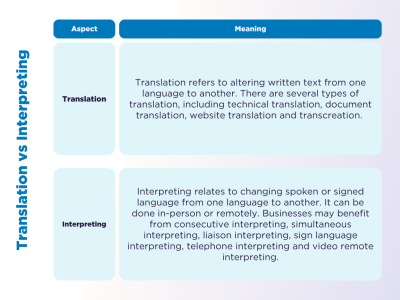𝘈𝘱𝘱𝘳𝘰𝘹 𝘳𝘦𝘢𝘥 𝘵𝘪𝘮𝘦: 4 𝘮𝘪𝘯𝘴🕒
Nearly half (49.5%) of Londoners are bilingual and can speak at least two languages, a 2024 study found.
Multilingualism is on the rise and as it grows, so does the need for businesses to communicate and engage in different languages.
And that’s where two of the big players of global communication come in: translation and interpreting.
During our 18 years in the industry and when chatting with potential clients, we often see people use the terms interchangeably. But it’s worth knowing that they refer to two separate ideas.
Translation vs interpreting - here is the short of it:
Translation refers to altering written text from one language to another. On the other hand, interpreting relates to changing spoken or signed language from one language (a source language) to another.
But there is much more to it than just a definition, so read on as we explain.
Interpreting vs Translation: in more detail
There are a few types of interpreting solutions that businesses might find useful:
(Note, interpreting can be done in-person or remotely).
- Consecutive interpreting - interpreters will listen to the speaker and when they pause, they will then repeat what has been said in another language. They may take notes using symbols for longer parts of speech. This practice is handy for meetings, interviews and negotiations.
- Simultaneous interpreting - interpreting occurs without pauses. The interpreter listens to the sentence and offers a real-time translation of the spoken word. This method is often used at events and conferences.
- Liaison interpreting - this involves interpreting in and out of the language required. This could use the consecutive or simultaneous method.
- Sign language interpreting - sign language interpreting, such as BSL or ASL, may be used for participants in a business meeting or event that are deaf or hard of hearing.
- Telephone interpreting - this offers a fast, reliable solution for clear communication without the need for face-to-face interaction.
- Video remote interpreting (VRI) - allows individuals to access interpreters through video conferencing technology. Think of remote services like Zoom, Skype, Google Meet, etc.
These all relate to spoken or signed language and occur in real-time or just following it.
Translation, on the other hand, can occur anytime really. As translation services relate to written text, they can involve:
- Technical translation: for industries such as medical and legal, they require industry-specific translators to understand the complex language and references involved. Therefore, your content is converted with precision and clarity.
- Document translation: this can cater to personal, legal and business needs. Whether it be legal documents, medical records, birth certificates, passports, applications, business documents or bank statements, they can all be translated.
- Website translation: website translation services cover a wide range of content types, including landing pages, content, product descriptions, catalogues and policies. To reach a wider audience, explore multilingual SEO solutions that optimise your website for search engines in multiple languages.
- Transcreation: Standard translation doesn’t always make sense in other languages, so transcreation takes into account the cultural differences and nuances of various demographics and languages.

Translation Case Study: Royal Pharmaceutical Society
As a Great Britain-wide organisation based in Wales, the Royal Pharmaceutical Society needed regular access to translations to publish information in Welsh and English.
So, they turned to Wolfestone.
“The quality of the translation work and the speed of turn around to meet our business needs has been outstanding. The regular contact from Wolfestone to check customer satisfaction has been very much appreciated and has provided us with an excellent customer experience. Offers of preferential discounts has added to our experience, providing excellent incentives to stay with Wolfestone as a customer.”
Of course, as this is text-based, it calls for translation services. However, if it was spoken language in Welsh that needed to be turned into English, that would require interpretation.
Use Cases
Here are some fictional situations where we outline which is more suitable between interpreting and translation services:
Scenario 1: A medical appointment in one day
If you are welcoming someone for an emergency appointment in a remote town in a matter of 24 hours and they don’t speak fluent English, then Video Remote Interpreting is the best option.
This is because it is much more challenging to get an interpreter on-site in time, in comparison to one that is remote and can work from anywhere.
Also, the interpreter is key here so the patient can understand any medical jargon and complex terminology that will need to be conveyed.
Scenario 2: Hosting a conference
Let’s say your business is hosting an end-of-year conference. All your clients, suppliers, staff and partners will be there. Having looked at the sign-up sheet and attendee details, you know that two of your clients use British Sign Language (BSL).
Therefore, you should organise for BSL interpreters to attend the event in-person and to sign the speeches and group discussions on the stage.
Scenario 3: Hospitalised abroad
A staff member of yours is hospitalised abroad in Chile on a work trip. To be able to assess her medical records, staff need a quick turnaround for the translation of their medical records.
Here, document translation is the best service to use to take these documents from English to Chilean Spanish.
Translation vs Interpreting: Which is the right service for my business?
Well, this depends on whether what you want to change from one language to another is text or spoken/signed language.
If you need text going from English to Spanish, translation is your service. On the other hand, if spoken Spanish needs to be repeated in English, interpreting is what you need.
Conclusion
Hopefully you can now differentiate between translation and interpreting better and you are aware of some of the situations where each is best suited.
Either way, both are beneficial in making content more accessible to consumers or including and appealing to a larger audience. But make sure you know what you need.
Explore our translation or interpreting services and get a quote today.
𝘑𝘢𝘤𝘬 𝘸𝘳𝘪𝘵𝘦𝘴 𝘢𝘣𝘰𝘶𝘵 𝘵𝘳𝘢𝘯𝘴𝘭𝘢𝘵𝘪𝘰𝘯, 𝘭𝘰𝘤𝘢𝘭𝘪𝘴𝘢𝘵𝘪𝘰𝘯 𝘢𝘯𝘥 𝘮𝘰𝘳𝘦 𝘭𝘢𝘯𝘨𝘶𝘢𝘨𝘦 𝘴𝘰𝘭𝘶𝘵𝘪𝘰𝘯𝘴 𝘧𝘰𝘳 𝘞𝘰𝘭𝘧𝘦𝘴𝘵𝘰𝘯𝘦. 𝘏𝘦 𝘭𝘰𝘷𝘦𝘴 𝘵𝘰 𝘧𝘪𝘯𝘥 𝘳𝘦𝘢𝘭-𝘭𝘪𝘧𝘦 𝘦𝘹𝘢𝘮𝘱𝘭𝘦𝘴 𝘰𝘧 𝘸𝘩𝘦𝘯 𝘴𝘰𝘭𝘶𝘵𝘪𝘰𝘯𝘴 𝘩𝘢𝘷𝘦 𝘢𝘯𝘥 𝘩𝘢𝘷𝘦𝘯'𝘵 𝘸𝘰𝘳𝘬𝘦𝘥 𝘵𝘰 𝘱𝘳𝘰𝘷𝘪𝘥𝘦 𝘢𝘴 𝘮𝘶𝘤𝘩 𝘳𝘦𝘭𝘢𝘵𝘢𝘣𝘭𝘦, 𝘰𝘳𝘪𝘨𝘪𝘯𝘢𝘭 𝘤𝘰𝘯𝘵𝘦𝘯𝘵 𝘵𝘰 𝘵𝘩𝘦 𝘢𝘶𝘥𝘪𝘦𝘯𝘤𝘦 𝘢𝘴 𝘱𝘰𝘴𝘴𝘪𝘣𝘭𝘦.







